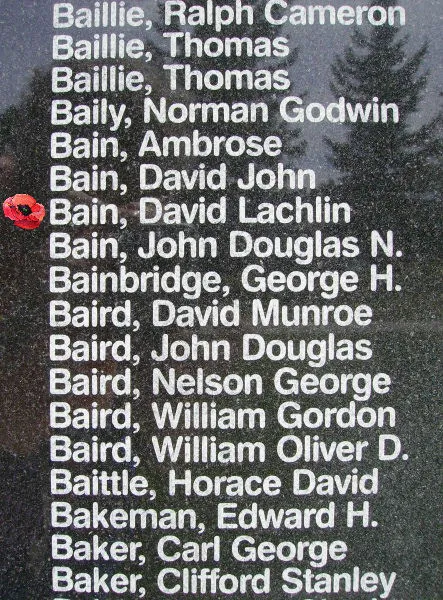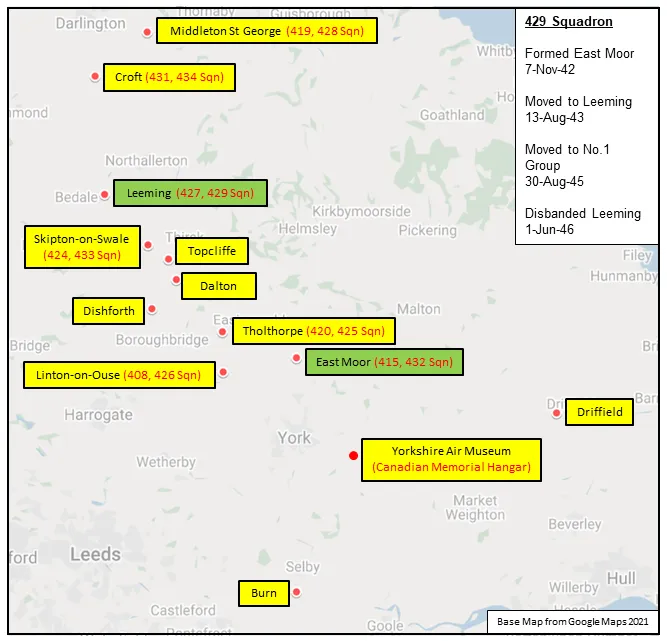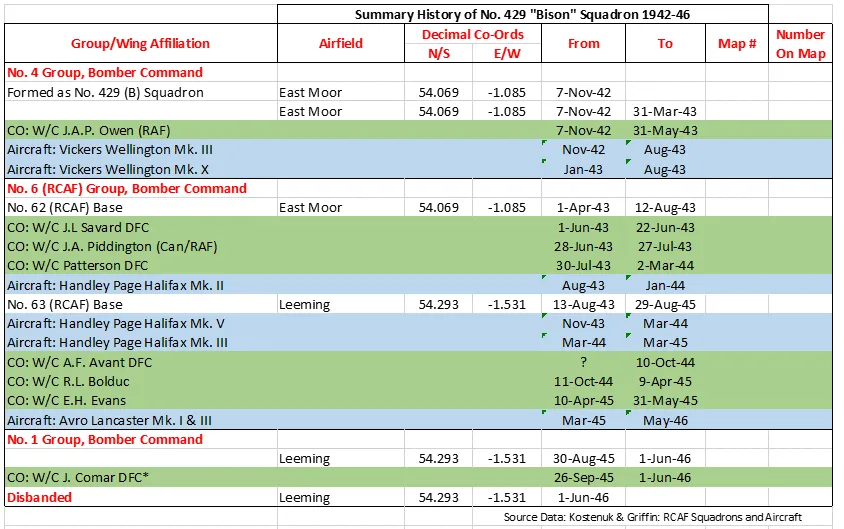Bain, David Lachlin (Warrant Officer 2)
Killed in Action 1943-March-30


Birth Date: 1916
Born:
Parents: James M & Jean Sutherland Bain, Vancouver, BC
Spouse:
Home: Vancouver, British Columbia
Enlistment:
Enlistment Date: unkown date
Service
RCAF
Unit
429 (B) Sqn- Squadron
Fortunae Nihil Nothing to chance
Base
RAF East Moor
Rank
Warrant Officer 2
Position
Navigator
Service Numbers
R/106671
Target
Crew or Other Personnel
Wellington BK540
Wellington serial: BK540

Vickers Wellington B. Mk. III (Serial No. X3763), coded KW-E, No. 425 'Alouette' (B) Squadron, RCAF, late summer of 1942
The Vickers Wellington was a British twin-engined, long-range medium bomber. It was designed during the mid-1930s at Brooklands in Weybridge, Surrey. Led by Vickers-Armstrongs' chief designer Rex Pierson, a key feature of the aircraft is its geodetic airframe fuselage structure, which was principally designed by Barnes Wallis. Development had been started in response to Air Ministry Specification B.9/32, issued in the middle of 1932, for a bomber for the Royal Air Force. This specification called for a twin-engined day bomber capable of delivering higher performance than any previous design.
The Wellington was used as a night bomber in the early years of the Second World War, performing as one of the principal bombers used by Bomber Command. During 1943, it started to be superseded as a bomber by the larger four-engined "heavies" such as the Avro Lancaster. The Wellington continued to serve throughout the war in other duties, particularly as an anti-submarine aircraft.
It holds the distinction of having been the only British bomber that was produced for the duration of the war, and of having been produced in a greater quantity than any other British-built bomber. The Wellington remained as first-line equipment when the war ended, although it had been increasingly relegated to secondary roles. The Wellington was one of two bombers named after Arthur Wellesley, 1st Duke of Wellington, the other being the Vickers Wellesley.
In August 1936, an initial order for 180 Wellington Mk I aircraft, powered by a pair of 1,050 hp (780 kW) Bristol Pegasus radial engines, was received by Vickers; it had been placed so rapidly that the order occurred prior to the first meeting intended to decide the details of the production aircraft. In October 1937, another order for a further 100 Wellington Mk Is, produced by the Gloster Aircraft Company, was issued; it was followed by an order for 100 Wellington Mk II aircraft with Rolls-Royce Merlin X V12 engines. Yet another order was placed for 64 Wellingtons produced by Armstrong Whitworth Aircraft. With this flurry of order and production having been assured by the end of 1937, Vickers set about simplifying the manufacturing process of the aircraft and announced a target of building one Wellington per day.
A total of 180 Wellington Mk I aircraft were built; 150 for the RAF and 30 for the Royal New Zealand Air Force (RNZAF) (which were transferred to the RAF on the outbreak of war and used by 75 Squadron). In October 1938, the Mk I entered service with 9 Squadron. The Wellington was initially outnumbered by the Handley Page Hampden (also ordered by the Ministry to B.9/32) and the Armstrong Whitworth Whitley (to B.34/3 for a 'night' bomber) but outlasted both rival aircraft in service. The Wellington went on to be built in 16 separate variants, in addition to two training conversions after the war. The number of Wellingtons built totalled 11,462 of all versions, a greater quantity produced than any other British bomber. On 13 October 1945, the last Wellington to be produced rolled out. Wikipedia
Unit Desciption
429 (B) Sqn Fortunae Nihil ("Bison")
History of the Squadron during World War II (Aircraft: Wellington III, X, Halifax II, V, III, Lancaster I, III)

No 429 Squadron was the 10th bomber unit and 27th squadron formed by the RCAF overseas in WWII. It was formed in November 1942 at East Moor, Yorkshire, UK ![]() as part of No 4 Group of RAF Bomber Command. On April 1, 1943 it became part of No 6 (RCAF) Group at No 62 (RCAF) Base, still remaining at East Moor until August 1943, when it moved to Leeming, Yorkshire
as part of No 4 Group of RAF Bomber Command. On April 1, 1943 it became part of No 6 (RCAF) Group at No 62 (RCAF) Base, still remaining at East Moor until August 1943, when it moved to Leeming, Yorkshire ![]() as part of no 63 (RCAF) Base: it remained at Leeming until its disbandment in May 1946. It undertook strategic and tactical bombing operations. After the cessation of hostilities in Europe, it remained in England and transferred to No 1 Group, where it was engaged in transporting troops from Italy (Operation DODGE).
as part of no 63 (RCAF) Base: it remained at Leeming until its disbandment in May 1946. It undertook strategic and tactical bombing operations. After the cessation of hostilities in Europe, it remained in England and transferred to No 1 Group, where it was engaged in transporting troops from Italy (Operation DODGE).
The squadron, with squadron code AL, flew Vickers Wellington Mks III and X until August 1943, when it re-equipped with Handley-Page Halifax Mk II, which it flew between August 1943 and January 1944, and Mk V between November 1943 and March 1944. These were superseded by Halifax Mk III aircraft in March 1944. In March 1945, the squadron re-equipped with Lancaster Mk I and III. In summary of its activities, it flew 3221 sorties, including airlifting 1055 PoWs back to England, for the loss of 71 aircraft. 9356 tons of bombs were dropped. The squadron was awarded45 DFCs and 2 Bars to DFC, 1 AFC, 1 CGM and 7 DFMs. Battle Honours were: English Channel and North Sea 1943-45, Baltic 1943-45, Fortress Europe 1943-44, France and Germany 1944-45, Biscay Ports 1943-44, Ruhr 1943-45, Berlin 1943-44, German Ports 1943-45, Normandy 1944, Rhine, Biscay 1943-44. Wikipedia,Moyes, Kostenuk and Griffin
Squadron History (Bomber Command Museum PDF)
Maps for Movements of 429 Squadron 1942-46

429 Squadron History Summary 1942-46

History of the Squadron Post-WWII (Aircraft: Buffalo, Hercules, Globemaster)
The squadron was reactivated at St. Hubert, Quebec ![]() on 21 August 1967 as a Tactical Transport Unit. It flew de Havilland CC-15 Buffalo aircraft for the Canadian Forces Mobile Command and was integrated into the Canadian Armed Forces on 1 February 1968. In August 1981 it was renamed 429 Transport Squadron and moved to CFB Winnipeg
on 21 August 1967 as a Tactical Transport Unit. It flew de Havilland CC-15 Buffalo aircraft for the Canadian Forces Mobile Command and was integrated into the Canadian Armed Forces on 1 February 1968. In August 1981 it was renamed 429 Transport Squadron and moved to CFB Winnipeg ![]() . The final move was in 1990 to 8 Wing in Trenton, Ontario
. The final move was in 1990 to 8 Wing in Trenton, Ontario ![]() . The squadron was disbanded in 2005.
. The squadron was disbanded in 2005.
Two years later in August 2007, 429 Squadron was again re-activated, this time operating the CC-177 Globemaster III strategic transport aircraft. It used these new aircraft in support of Canada's operations in Afghanistan.